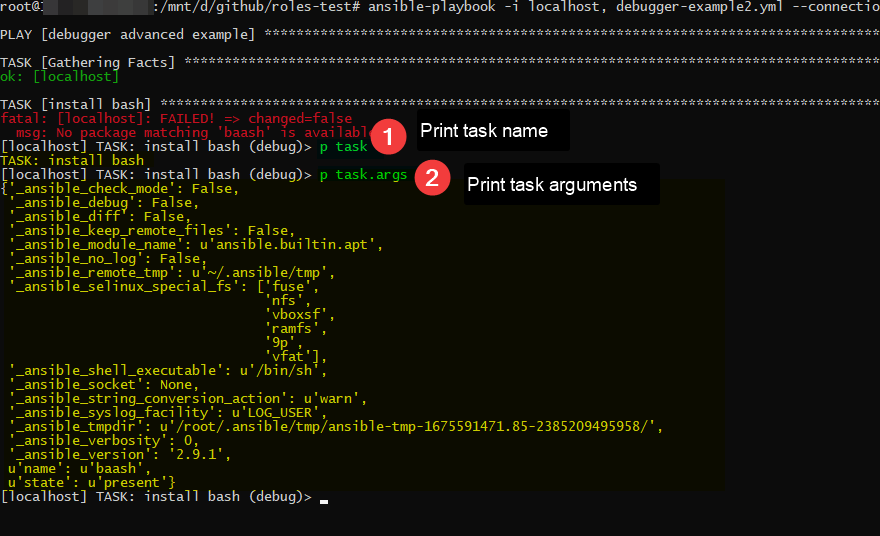Ansible Troubleshooting Part2
Overview
Ansible Troubleshooting Part 2
In the first blog Ansible Troubleshooting part 1. I showed some basic techniques. Now in this part I show one some more advanced technique.
Ansible Debugger
Ansible contains a debugger that you can use in a running Ansible process. To get some more information. You can use the debugger keyword to enable (or disable) the debugger for a specific play, role, block, or task.
The debugger keyword accepts five values:
| Value | Description |
|---|---|
| always | Always invoke the debugger, regardless of the outcome. |
| never | Never invoke the debugger, regardless of the outcome. |
| on_failed | Only invoke the debugger if a host is unreachable. |
| on_skipped | Only invoke the debugger if the task is skipped. |
1# Example debugger on task level.
2- name: Execute a command
3 ansible.builtin.command: "false"
4 debugger: on_failed
1---
2# Example debugger on play level
3- hosts: all
4 debugger: on_failed
5 gather_facts: no
6 tasks:
1# Example debugger on multiple level. The task level overrides the play level
2- name: Play
3 hosts: all
4 debugger: never
5 tasks:
6 - name: Execute a command
7 ansible.builtin.command: "false"
8 debugger: on_failed
When the play reaches a debug point. I changes the shell to a debug shell. You can use Python command here. Ansible is python under the hood.
printing the values
Then you can check the specific values
| What | Command |
|---|---|
| Task name | p task |
| Task input arguments | p task.args |
| Specific input argument for example name | p task.args['name'] |
| Task variables | p task_vars |
| Specific task var for example package | p task_vars['package] |
So you can see the values in the output.
In below example we see that we use p task to print
the current task name and p task.args to print the current task
arguments.

changing values
With the debugger you can change the values in runtime. In the example below we make a mistake. The package name is misspelled. We use the the task.args command toc change the values.
1---
2# This playbook is used as example to show debugger commands. The var package is misspelled. baash instead of bash.
3- name: debugger advanced example
4 hosts: all
5 debugger: on_failed
6 vars:
7 package: baash
8 tasks:
9 - name: install bash
10 ansible.builtin.apt:
11 name: "{{ package }}"
12 state: present

update the vars
In this example we use the task_vars command to update the package variable and update the task and rerun the task.

Step trough the play
As you see you can run the task again with redo or r. Or continue the play and go to the next task with c.
Other options to activate the debugger.
As you can read you can activate the debugger with the debugger keyword in the play or task. But you can do this also in the
- Environment variables
- Ansible CFG
Enable the debugger in the environment variables
Put the ANSIBLE_ENABLE_TASK_DEBUGGER=True in front of the ansible-playbook command
1ANSIBLE_ENABLE_TASK_DEBUGGER=True ansible-playbook -i localhost, debugger-example2.yml --connection=local
Enable the debugger in the Ansible CFG
Add the following line to the Ansible CFG.
[defaults]
enable_task_debugger = True
Using the debugger on the free strategy will cause no further tasks to be queued or executed while the debugger is active. Additionally, using redo on a task to schedule it for re-execution may cause the rescheduled task to execute after subsequent tasks listed in your playbook.
Conclusion
Ansible debugger is very strong tool to troubleshoot some more complex problems and to do some debugging in the play. The examples are easy ones to show the possibilities. Ansible debugger can help you identify issues in your Ansible playbooks more quickly. If you have any questions leave a comment below or contact me. For the possibilities see the about page.